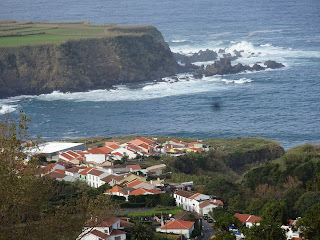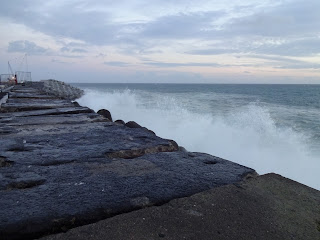The third great caldera and lake, Lagoa do Fogo, is located in the middle of the island. From the peak at the rim of the crater, you can see most of the island including both the north and south coasts.
Communication towers at the peak, Pico Barrosa, overlooking Lagoa do Fogo and most of the entire island.
Lagoa do Fogo; a fishing boat appears as a speck on the surface of the lake.
We visited the black sand beach of Ribeira Grande on the north shore. Dawn needs to pay more attention to incoming waves.
A view looking east of much of the north shore of the island. A minor volcanic cone is on our right.
We made a second visit to the west end of the island when the weather was better (although the weather was never a problem, some days just had fewer clouds). Sao Miguel has about 130K to 140K residents; it might be interesting to visit some of the less inhabited islands.
Surprisingly, our Danube river cruise, the centerpiece of our visit to Europe, was perhaps the least satisfying part of our trip. Blame low water levels for most of that. Long bus rides on crowded highways are not the same as floating down the river. But, additionally, a river cruise is a compromise in picking attractions that will appeal to the majority of the 120 passengers; instead of including only those that interest you most. Each of our other destinations was better than expected.
In Poland, we discovered English was more widely spoken than expected. We found some great restaurants, and our accommodations were excellent. Costs were modest. Kraków was as scenic as advertised. Zakopane was given only a short stay; we passed up some good hiking. Budapest is beautiful; although, staying in a five-star hotel may have influenced that conclusion. Visiting Sao Miguel in the Azores was a slight gamble; I really hadn't researched it much beforehand. But it has been a great visit. I can see us possibly returning and visiting more of the nine islands. For anyone living in the eastern US, it could be an attractive alternate to Hawaii.
Weather-wise, I think that we got lucky. Other than fog around Vienna, we have had great weather, but this late in the season, it could easily have been less favorable. We scheduled this late in order to include the cruise and arrive in DC at Thanksgiving.
Credit cards can be used for major purchases in all these places, but carrying some cash is also important. Taxis, laundry, small shops, some gas stations, park admissions, and street food require currency. In Poland, they want you to spend & receive change in zlotys. In Hungary, you can spend euros, but you will receive florints in change (300 florint = 1 euro). Germany, Austria, and Portugal all use euros. Dollars are a lesser currency; not desired, or accepted at an unfavorable exchange rate. We spend about 20-30 euros cash per day.
Our flight to Boston was 1 1/2 hours late, and it seems to happen frequently. They will not let you book a close (less than 2 hour) connection. But, that made no difference because our flight to DC was 2 1/2 hours late; we arrived at DCA at 1:30am. Ouch! We have six days in Washington to catch up on our sleep. It will be a chance to spend time with our 15-month-old grandson and his family. Washington is experiencing its wettest November since 1877, and we are experiencing the coldest weather of our trip.
Communication towers at the peak, Pico Barrosa, overlooking Lagoa do Fogo and most of the entire island.
Lagoa do Fogo; a fishing boat appears as a speck on the surface of the lake.
We visited the black sand beach of Ribeira Grande on the north shore. Dawn needs to pay more attention to incoming waves.
A view looking east of much of the north shore of the island. A minor volcanic cone is on our right.
We made a second visit to the west end of the island when the weather was better (although the weather was never a problem, some days just had fewer clouds). Sao Miguel has about 130K to 140K residents; it might be interesting to visit some of the less inhabited islands.
Surprisingly, our Danube river cruise, the centerpiece of our visit to Europe, was perhaps the least satisfying part of our trip. Blame low water levels for most of that. Long bus rides on crowded highways are not the same as floating down the river. But, additionally, a river cruise is a compromise in picking attractions that will appeal to the majority of the 120 passengers; instead of including only those that interest you most. Each of our other destinations was better than expected.
In Poland, we discovered English was more widely spoken than expected. We found some great restaurants, and our accommodations were excellent. Costs were modest. Kraków was as scenic as advertised. Zakopane was given only a short stay; we passed up some good hiking. Budapest is beautiful; although, staying in a five-star hotel may have influenced that conclusion. Visiting Sao Miguel in the Azores was a slight gamble; I really hadn't researched it much beforehand. But it has been a great visit. I can see us possibly returning and visiting more of the nine islands. For anyone living in the eastern US, it could be an attractive alternate to Hawaii.
Weather-wise, I think that we got lucky. Other than fog around Vienna, we have had great weather, but this late in the season, it could easily have been less favorable. We scheduled this late in order to include the cruise and arrive in DC at Thanksgiving.
Credit cards can be used for major purchases in all these places, but carrying some cash is also important. Taxis, laundry, small shops, some gas stations, park admissions, and street food require currency. In Poland, they want you to spend & receive change in zlotys. In Hungary, you can spend euros, but you will receive florints in change (300 florint = 1 euro). Germany, Austria, and Portugal all use euros. Dollars are a lesser currency; not desired, or accepted at an unfavorable exchange rate. We spend about 20-30 euros cash per day.
Our flight to Boston was 1 1/2 hours late, and it seems to happen frequently. They will not let you book a close (less than 2 hour) connection. But, that made no difference because our flight to DC was 2 1/2 hours late; we arrived at DCA at 1:30am. Ouch! We have six days in Washington to catch up on our sleep. It will be a chance to spend time with our 15-month-old grandson and his family. Washington is experiencing its wettest November since 1877, and we are experiencing the coldest weather of our trip.






















































